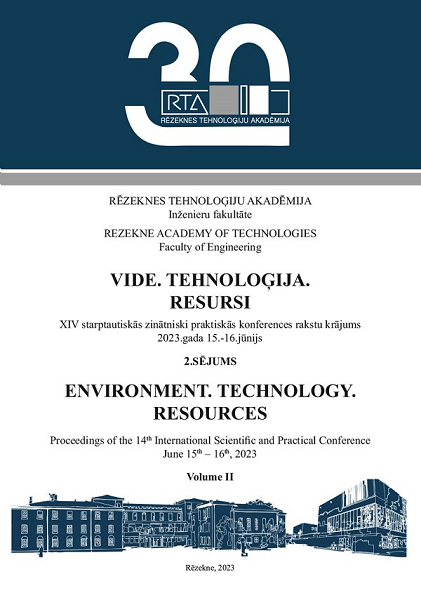USING COMMUNICATION AND COLLABORATION TOOLS IN VIRTUAL LEARNING ENVIRONMENTS MOODLE FOR MATHEMATICS IN PRIMARY SCHOOL
DOI:
https://doi.org/10.17770/etr2023vol2.7280Keywords:
mathematics, primary school students, virtual learning environments MoodleAbstract
With the advancement of information and communication technologies, teaching mathematics in a real-life classroom is combined with teaching in a virtual learning environment (VLE). It is important to determine how a primary school teacher can use VLE communication and collaboration tools to teach mathematics primary school students.
Participants – 4th grade students ((n = 51). Access to quantitative studies has been chosen for the study. Methods of study: Analysis of scientific literature, testing, descriptive statistics, and inference statistics. Data from the pilot study and the educational experiment were processed using version 23 of the IBM SPSS Statistical Package for Social Sciences. The normality of the variable distribution was tested using the Shapiro-Wilk test. Throughout the research, decisions are taken at a value a = 0.05. Study adhered to the fundamental principles of the European Code of Conduct for Study Ethics. The curator of the education was in contact with the students and their parents by e-mail and using the VLE communication and collaboration tools (messages, forums, feedback). The aim was to find out whether the number of emails and messages sent by the curator affected the students’ learning time in the VLE. The hypothesis of zero Pearson coefficient equality in the population is checked.
There was a statistically significant weak relationship between the number of emails sent by the curator of the curriculum, the number of messages for students and the time spent by the student for the lessons of the curriculum. There was a mean relationship in the boy’s group, but there was no statistically significant relationship in girls’ group.
There was also a statistically significant weak relationship between e-mails sent by the curriculum curator, the number of messages sent to students and the evaluation of the lessons of the curriculum. There was an average relationship in the boy’s group, but in the girl’s group there was no statistically significant relationship between the emails sent by the tutor, the number of messages to students and the evaluation of the lessons of the curriculum. This confirms the theory of constructivism that VLE is suitable for education because teachers can act as learning facilitators to communicate with each other during learning.
References
H. Bouta and S. Retalis, “Enhancing primary school children collaborative learning experiences in maths via a 3D virtual environment,” Education and Information Technologies, vol. 18, no. 4, pp. 571–596, 2013.
E. Codreanu, C. Michel, M.E. Bobiller-Chaumon and O. Vigneau, “The Acceptance of VLEs (Virtual Learning Environments) by Primary School Teachers,“ In CSEDU 2016-Proceedings of the 8th International Conference on Computer Supported Education, pp. 299–307, 2016.
S. Hassan, H. Waheed, N.R. Aljohani, M. Ali, S. Ventura and F. Herrera, “Virtual learning environment to predict withdrawal by leveraging deep learning,” International Journal of Intelligent Systems, vol. 34, no. 8, pp. 1935–1952, 2019.
H. Kim and F. Ke, “Effects of game-based learning in an OpenSim-supported virtual environment on mathematical performance, “ Interactive Learning Environments, vol. 25, no. 4, pp. 543– 557, 2017.
A. Barana, A. Brancaccio, M. Esposito, M. Fioravera, M. Marchisio, C. Pardini and S. Rabellino, “Problem solving competence developed through a virtual learning environment in a European context,“ International Scientific Conference eLearning and Software for Education, vol. 1, pp. 455–463, 2017.
A. Targamadzė, Virtualusis mokymas. Teorija ir praktika. Vilnius: Vitae litera, 2020.
R. Kondratavičienė, “Pradinių klasių mokinių vertybių ugdymas naudojant informacines komunikacines technologijas,” Pedagogika, vol. 133, no. 1, pp. 202–216, 2019.
V. Dagienė, “Tiriamojo darbo „Atvirasis kodas švietime“ ataskaita,” Vilnius: Lietuvos respublikos švietimo ir mokslo ministerija, 2012.
Nuotolinio mokymo(si) / ugdymo(si) vadovas, 2022. [Online]. Available: https://www.emokykla.lt/upload/nuotolinis/Nuotolinio%20mokymo%20Vadovas_3.pdf, 2022. [Accessed: March 20, 2023].
G. Taujanskienė, A. Skripkienė and I. Klizienė, “Virtualios mokymo (si) aplinkos įtaka pradinių klasių mokinių matematikos mokymosi pasiekimams,” Jaunųjų Mokslininkų Darbai, vol. 50, no. 1, pp. 54–60, 2020.
W. Angreanisita, Z. Mastur and R. Rochmad, “Mathematical Literacy Seen from Learning Independency in Blended Learning with Project Based Learning Assisted by Moodle,” Unnes Journal of Mathematics Education Research, vol. 10, pp. 155–161, 2021.
ALLEA - All European Academies, The European Code of Conduct for Research Integrity, Berlin, 2017. [Online]. Available: http://www.allea.org/wp- content/uploads/2017/05/ALLEA-European-Code-of-Conduct-for-Research-Integrity-2017.pdf. [Accessed: March 20, 2023].
K. Morgan-Short ans H. W. Bowden, “Processing instruction and meaningful output-based instruction: effects on second language development,” Studies in second language acquisition, vol. 28, no. 1, pp. 31-65, 2006.
S. J. Wolf and B. J. Fraser, “Learning environment, attitudes and achievement among middle-school science students using inquiry-based laboratory activities,” Research in Science Education, vol. 38, no. 3, pp. 321–341, 2008.
B. Rienties, D. Tempelaar, Q. Nguyen and A. Littlejohn, “Unpacking the intertemporal impact of self-regulation in a blended mathematics environment,”. Computers in Human Behavior, vol. 100, pp. 345–357, 2019.



